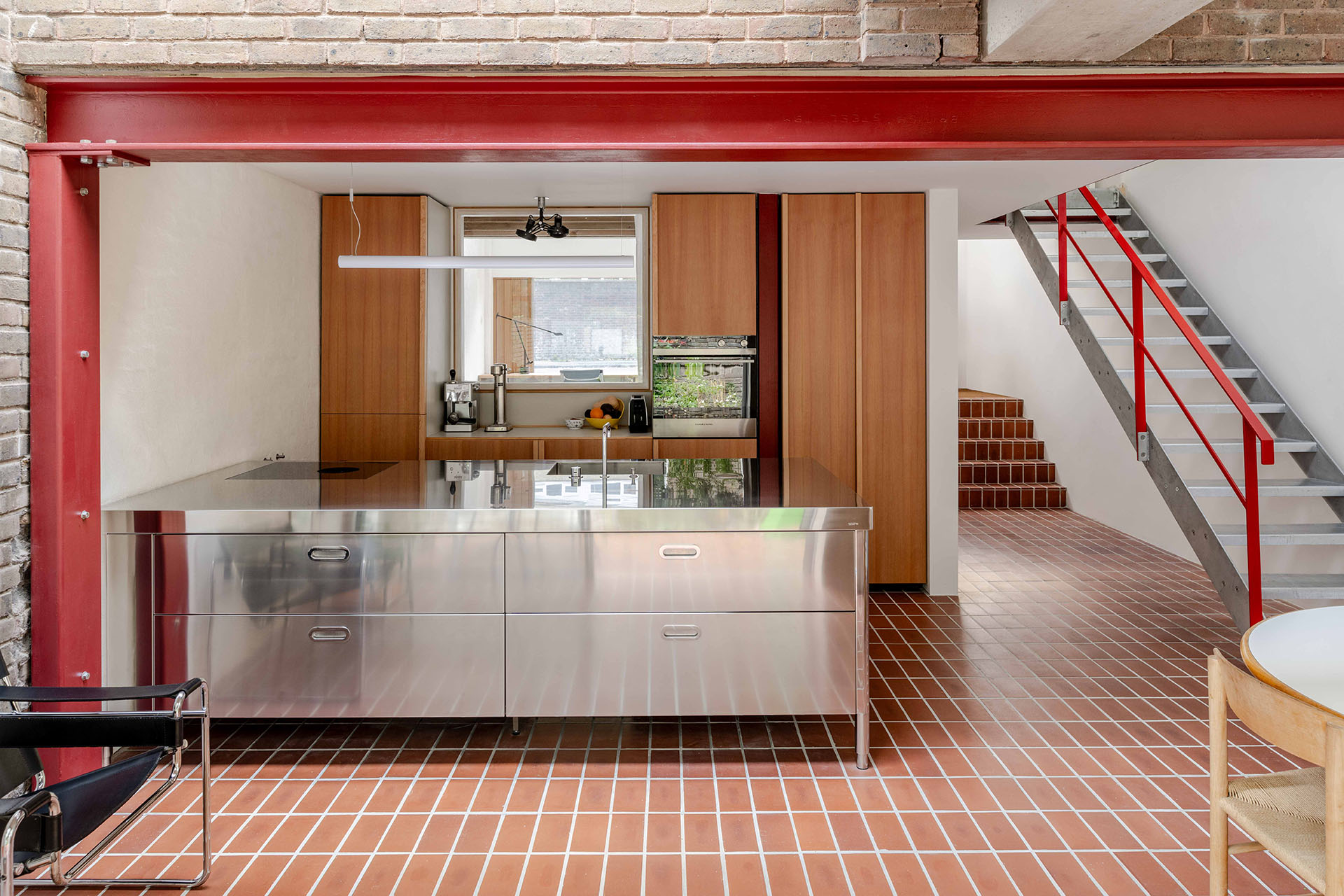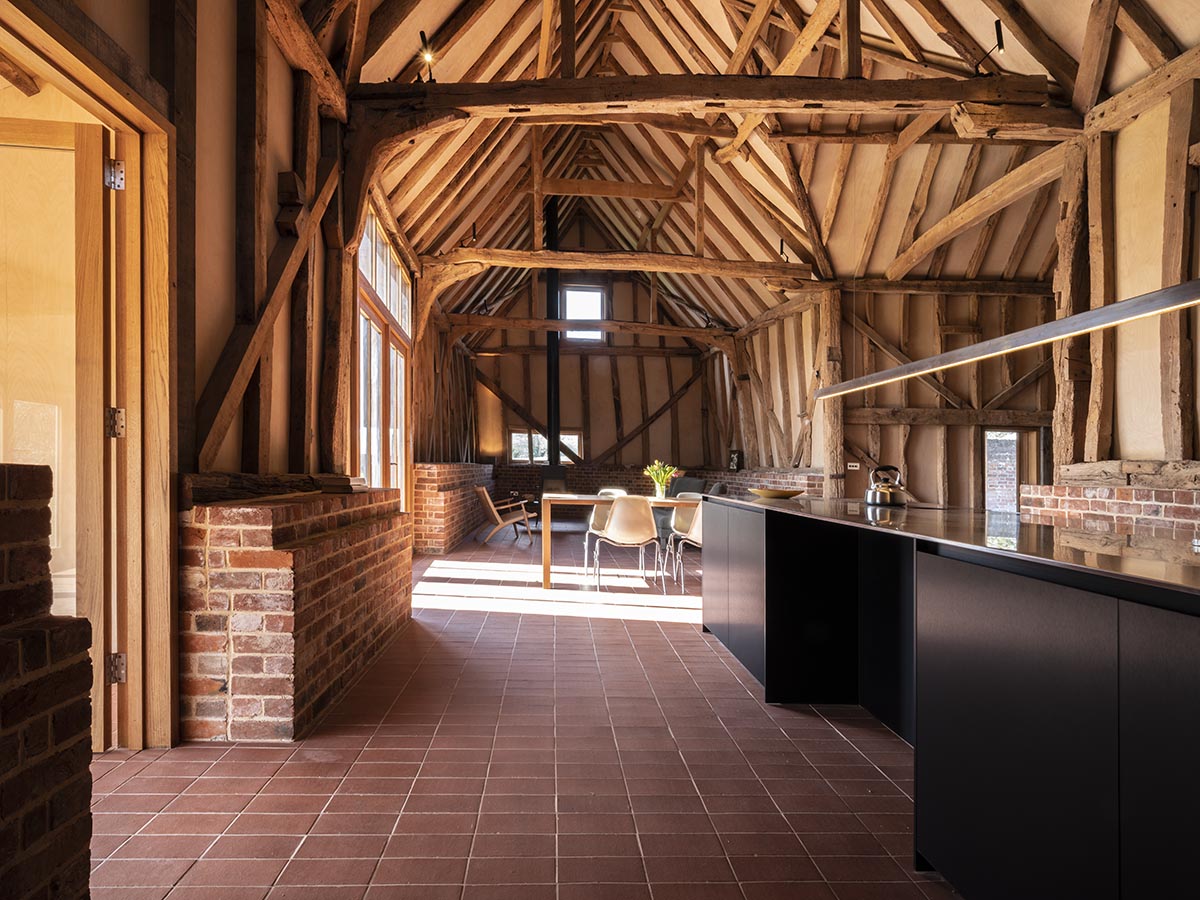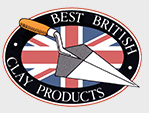Staffordshire red quarry tiles

Our Staffordshire red quarry tiles provide a very good match to red quarry tiles of old, their rich colour working particularly well with Victorian restoration projects.
![]() Frost resistant
Frost resistant
Suitable for exterior & interior
![]() High slip resistance
High slip resistance
Click here for more info
Category R11 C
Case Studies
Jesus College Cambridge


Architects Niall Mclaughlin are a practice that puts a strong emphasis on the inventive use of building materials, the qualities of light and the relationship between the building and its surroundings. At Jesus College Cambridge, the project was to refurbish and extend a Grade II listed building and staying within the historic footprint of the building was a key requirement. Oak, stone, brick and quarry tiles were chosen as a consistent pallette of materials throughout the project, unifying the refurbished elements with the new build and all perfectly suiting the historical context of the site. Tom Mcglyn, the project architect explains "there were already old terracotta square quarry tiles in use internally in the existing circulation areas and there was considerable brick used within the building. Internally, we wanted to use a robust material for the floors in the circulation areas, a material that could even be external, and Ketley quarry tiles fitted this brief whilst also paying homage to the existing square quarries and the brick lined walls in the new design"
Van Gogh House


A Grade II listed Georgian terrace, home to Vincent Van Gogh in 1873 has been meticulously restored over 6 years using original materials and traditional techniques. Ketley Staffordshire red quarry tiles have been laid in the new kitchen extension as well as the new artists studio. "It was important that these new additions complemented the house’s Victorian history and the original palette of clay, lime plaster, and timber, and using Staffordshire clay quarry tiles sourced from Ketley Brick was key to the design of the modern extensions", explains designer Livia Wang.
Draft House Milton Keynes


This new Draft House pub in Milton Keynes uses Staffordshire red brick sized quarry tiles in a herringbone pattern. Naomi Doran from Relic Interiors London, who designs the Draft Houses explains, "I love these floor tiles as they give the impression that they are integral to the building, that they have always been there and have just been uncovered. Unlike a lot of other floor tiles that have perfect regular finishes, these tiles are effectively thin bricks. Their finish has imperfections and irregularities that can transform an interior and give the space a warmth and character from the moment they are laid. The variety of colours and sizes available in the range makes them very versatile and I find that I can achieve a very different look by using a different colour or laying pattern."
Fittings
Quarry Tile Fittings

These products shown here match our rectangular quarry tiles 102mm x 215mm. Similar products are available to match our squares 100mm x 100mm and 150mm x 150mm. Please contact us for further details.
Bullnose Stretcher
Bullnose Header


Bullnose Return


Ribbed Nosing


Environmental
Place of Manufacture: Brierley Hill, UK
Environmental Management: 14001 Download Certificate
Quality Management : 9001 Download Certificate
Download the Ketley Quality and Environmental Policy
Energy: Cured in gas fired kilns to 1130
Raw materials: Etruria Marl Clay from our local quarry in Brierley Hill
Lifespan: Ketley's bricks are the toughest and most durable bricks you can buy.
Recyclability: Can be crushed and used as aggregate and/or as an inert bulk fill
Packaging: We keep packaging to a minimum using wooden pallets. We do not shrink wrap or use plastic straps.
Find out more about Ketley's approach to sustainability
Click for the Brick Development Association infograhic on Sustainability of Brick
See below the latest video about Sustainability of Brick from the Brick Development Association
Tech Spec
Ketley Quarry Tiles for flooring
Standard: BS EN 14411:2012
Ketley Quarry Tiles are manufactured from the same clay, using the same processes as the Ketley 50mm and 65mm pavers and deliver the same technical characteristics of very low water absorption, very high strength and unrivalled frost resistance.
| Quarry Tile | Joint size | Coverage per m2 |
|---|---|---|
| 215x102mm | 10mm | 40 |
| 215x102mm | 6mm | 42 |
| 215x102mm | 5mm | 43 |
| 215x65mm | 10mm | 60 |
| 150x150mm | 10mm | 40 |
Packing On pallets - 1350 pieces on a pallet for 215x102mm size pallet weight (incl pallet) 1240kg
1100 pieces on a pallet for 150x150mm size pallet weight (incl pallet) 1010kg
1890 pieces on a pallet for 215x 65mm size pallet weight (incl pallet) 1155kg
Weight per unit 215x102mm size - 0.9kg 150x150mm size - 0.9kg 215x 65mm size 0.6kg
Download Ketley Quarry Tile Specification Sheet
Download Ketley Quarry Tile Specification clause as a word document
|
Properties |
BS EN 14411 Group A1b requirement |
Typical values for Ketley Quarry tiles |
| DIMENSIONS AND SURFACE QUALITY | ||
|
length x width
215mm x 102mm 215mm x 65mm
100mm x 100mm
150mm x 150mm
|
average tolerance +/-2% to an individual maximum of +/- 4mm
|
length 215mm+/-2.5mm
width 102.5mm+/-1.5mm |
|
Thickness (18mm)
|
average tolerance +/-10%
|
+/-1mm
|
|
Straightness of sides
|
within ± 0.6%
|
0.2%
|
|
Rectangularity
|
within ±1%
|
0.2%
|
|
Surface flatness
|
centre curvature ± 1.5%
|
centre curvature +/-1.5mm
|
|
edge curvature ± 1.5%
|
edge curvature +/- 1mm
|
|
|
warpage ± 1.5%
|
warpage +/- 1.5mm
|
|
|
PHYSICAL PROPERTIES |
||
|
Breaking strength
|
Min 1100N
|
2995N
|
|
Water absorption
|
0.5 < 3%
|
1.5%
|
|
Resistance to deep abrasion
|
Max 275mm³
|
106mm³
|
|
Frost resistance
|
Value to be stated
|
No damage after 100 cycles
|
|
Slip resistance
|
Pendulum test results exceeding 36 indicate low slip potential
|
Dry value av 96
Wet value av of 58
on Slider 55 for Staffs Blue
Dry value av 63
Wet value av of 55
on Slider 96 for Brown Brindle
|
|
Inclined platform in shod conditions |
Category R11 which indicates that they are considered not to be slippery in wet or greasy conditions.
|
|
|
Inclined platform in wet barefoot conditions
|
Category C which is the highest rating for slip resistance.
|
|
|
|
|
|
|
Bond strength
|
C2 Cementatious adhesives
|
>1.0 N/mm²
|
|
Reaction resin adhesives
|
>2.0N/mm²
|
|
|
Mortar
|
0.15N/mm²
|
|
|
Moisture expansion
|
No requirement
|
Negligible
|
|
Reaction to fire
|
Value to be stated
|
A1
|
|
CHEMICAL PROPERTIES
Resistance to staining
|
Minimum requirement 3
|
Paste stain 5
Chemical/oxydising stain 4
Film stain 3
|
|
Chemical Resistance
|
|
NPD
|
Laying
Laying Quarry tiles
Download our guide to laying and cleaning Quarry Tiles
Download Ardex guide to fixing Ketley Quarry Tiles
During the floor laying operation the areas being treated should be accessible to no-one but the floor layers and should not be subjected to traffic until the bedding has stiffened and sufficient bond has developed between the bedding and the tile. The floor should be kept clean and free from cement and plaster droppings.
As a general guide the following fixing should be followed;
- A joint width of between 6 & 10 mm
- A bedding layer to be approximately 6mm for cement based adhesives, 15-25mm for cement mortar and up to 70mm for a semi dry bed.
- A screed would normally be applied with a thickness of 50mm.
- A separating layer may be used to isolate the slips or paving tiles and their bedding from the base, preventing stresses in the base affecting the floor finish. This method is not recommended for exterior applications.
When a screed is applied, the concrete base must be at least 4 weeks old. The screed must then be allowed to mature for at least 2 weeks before fixing commences, during which time it must be protected from rain and frost.
Bedding directly to the base can be used where the base is completely matured and where there is no risk of further shrinkage movement or where a damp-proof membrane is incorporated between the concrete base and screed. This method is suitable for external applications.
Care should be taken to incorporate appropriate falls and movement/expansion joints within the design of structure.
A suitable damp-proof membrane should be incorporated in the construction.
Quarry tiles should only be laid on a rigid bed with no voids underneath so the load applied to them is transferred through to the base. In situations where heavy loads are involved the strength of the installation can be improved by the use of a thicker paver as the transverse breaking load of a clay paving product is directly related to its thickness where all other factors are equal. It is advisable to select the material to resist the most arduous conditions likely to be imposed during the life of the product.
Grouting
Grouting of quarry tiles laid with wet cement-sand mortars or adhesives should not be carried out for 12 hours after laying the quarry tiles. Where a semi-dry mix method is used, tiles should be grouted within 4 hours of laying to ensure a full bond between the grout and the bedding.
Board should be laid over the tiled area to spread the load of the tiler when carrying out the grouting operation. The grouting mortar should be adapted for the width of the joint with a lower ratio of cement for wider joints. A mixture of 1:1 cement to fine dry sand by volume mixed to a paste with only the minimum of water for workability, should be used for joints of less that 3mm and a ratio of 1:3 for joints wider than 6mm. Avoid too wet a mix, as this will dry out rapidly and the grouting will crack and break out. Work in the grout in small joints with a squeegee action. In wider joints pointing is recommended. After the joints have been filled, scatter a dry 1:3 or 4 mortar mix over the joints: allow to dry for about 5 to 10 minutes, then brush away excess loose material with a soft bristle brush. Finally clean off the tiles with water and a cloth, avoid excess watering of the tiles in this operation.
If an impervious joint is required, additives may be used in the grout mix or proprietary ready grouts can be used. However advice should be sought from the manufacturers as to their suitability for the application. Attention should be paid to cleaning any proprietary grout or grouts mixed with additives off the surface of the Quarry tiles immediately.
Tiles should be cleaned as work proceeds. Such cleaning should be minimal with good workmanship.
For further information on fixing products and their suitability for your project please refer to the manufacturers listed below.
Instarmac www.instarmac.co.uk They supply a fully BS7533 compliant Ultrascape’s Mortar Paving System developed for constructing rigid paved areas offering a minimum construction life of 40 years. Relevant case studies, data sheets and COSH information can be downloaded from their website.
Cleaning
Cleaning Quarry Tiles
Download our guide to laying and cleaning Quarry Tiles
Under normal circumstances Quarry Tiles require little maintenance and can be kept clean by sweeping then washing with warm water to which a suitable non-soapy detergent has been added.
Clean and dry flooring surfaces possess a low slip potential, the majority of slip accidents occur in the presence of a contamination between the floor surface and foot. The likelihood of a slip occurring is greatly reduced if contamination is controlled by means of a cleaning and maintenance procedure. In order for a cleaning and/or maintenance regime to be effective there are a number of basic elements that should be considered:
-
Before establishing a floor cleaning protocol, the specific contaminants must be identified in order to enable the selection of the appropriate cleaning agent
-
The cleaning tools provided should be appropriate for use with the floor in question it may be necessary to assign dedicated tools for specific areas
-
Regular cleaning of the floor should be scheduled, specifying the responsible person and time of day or night (dependent on likely volume of pedestrian traffic) cleaning should take place
-
Clear instruction should be provided as to the cleaning requirements and procedures, correct use and disposal of detergents, emergency conditions and procedures and recording and reporting of maintenance operations
-
Wear, damage, debris and contaminants should be identified through routine inspection of floor surfaces.
Contamination cleansing routines are dependent upon a number of factors including the type of surface to be cleaned, the contamination present, the availability of chemical cleaning agents and the practicality of manoeuvring cleaning machinery in the given space. Beyond the method used, it is imperative to ensure all contaminates are removed following the cleansing process The freshly cleaned floor must be thoroughly rinsed with clean water to make certain that all cleaning agents are removed and the floor is dry on completion. Failure to conduct these last actions can lead to a build-up of concentrated contaminate and cleaning agent on the surface of floors. These contaminant and cleaning agent residues will combine with any water subsequently applied to form an emulsion that can spread over the floor’s surface, significantly increasing the slip potential.
Quarry Tiles should require only a small amount of cleaning on completion, and this only when the joints are hard. This should be done with a non-soapy, neutral, sulphate-free detergent and cleaned off with clean water. Strong detergents should not be used as they can cause scumming. Always damp tiles before applying a cleaning agent to avoid the cleaner being drawn into the body of the tile: the cleaning treatment is then restricted to the surface of the tile.
Difficult stains can be removed in one of three ways;
-
By the use of an abrasive soap. Steel wool should not be used as small particles ma be deposited in the grouting causing rust marks
-
By chemical means, by reaction with the appropriate solvent but due to the variety of materials that may cause staining it is recommended that advice is sought from organisations such as Lucideon in Stoke on Trent.
-
By bleaching to remove the colour from the stain, although this should not be done on a regular basis.
NB: The use of sealers and polishes on Quarry Tiles can make regular cleaning more difficult.
















-A.jpg)


